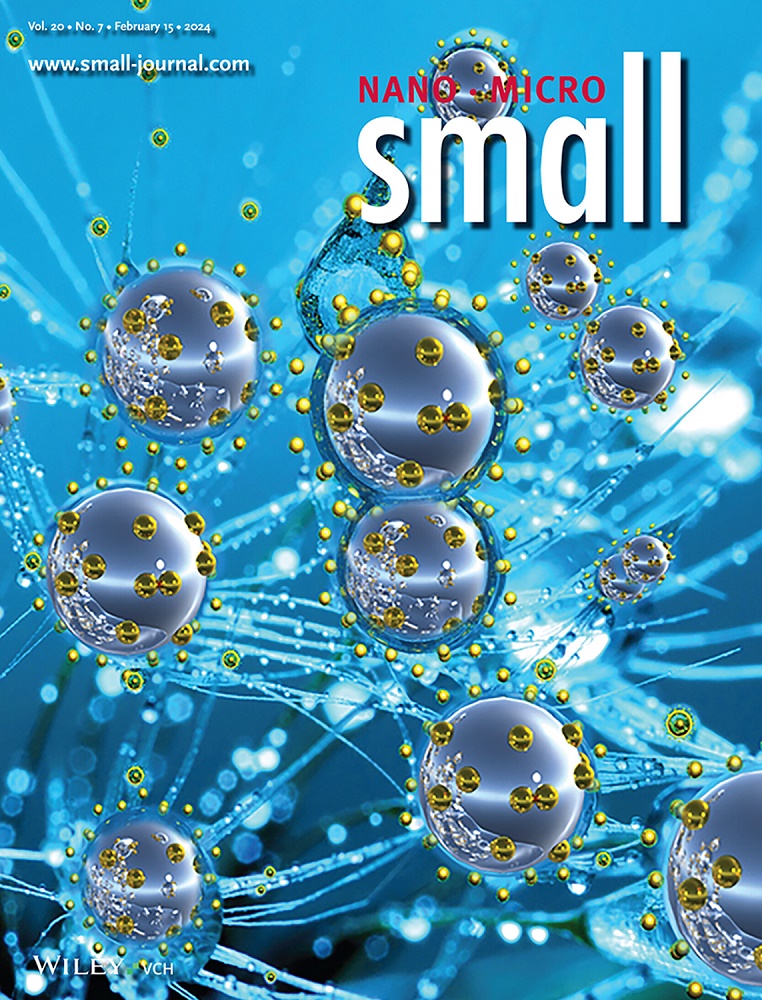多功能纳米探针伪装成细菌营养物质,用于深层组织内抗生素耐药细菌的特定磁共振成像和声动力失活。
IF 12.1
2区 材料科学
Q1 CHEMISTRY, MULTIDISCIPLINARY
引用次数: 0
摘要
目前的磁共振成像技术通常缺乏区分细菌感染和非细菌炎症的特异性。为了解决这一问题,合成了模拟细菌营养物质的多功能纳米探针,用于选择性磁共振成像和深部组织内抗生素耐药细菌的声动力失活。通过点击化学将叠氮化物功能化麦芽糖糖与炔修饰的锰血卟啉偶联,形成自组装纳米颗粒。这些探针利用细菌特异性atp结合盒(ABC)糖转运体进行选择性摄取。这些研究表明,革兰氏阳性和革兰氏阴性细菌的探针吸收率≈65%,而ABC转运蛋白缺陷突变体的吸收率可忽略不计(≈1%)。该探针具有高弛豫度(纵向达11.56 mm-1 s-1,横向达102 mm-1 s-1),能够检测耐甲氧西林金黄色葡萄球菌和耐多药大肠杆菌,其集落形成单位约为104。在小鼠中,他们区分了细菌性肾炎和非细菌性炎症,并将肿瘤中的细菌可视化,优于基于钆的药物。血卟啉成分提供了强大的声动力抗菌活性,实现>95%的体内细菌消除。本研究为深部组织细菌感染提供了精确的成像和治疗策略。本文章由计算机程序翻译,如有差异,请以英文原文为准。
Multifunctional Nanoprobes Camouflaged as Bacterial Nutrients for Specific Magnetic Resonance Imaging and Sonodynamic Inactivation of Antibiotic-Resistant Bacteria within Deep Tissues.
Current magnetic resonance imaging techniques often lack the specificity to distinguish bacterial infections from nonbacterial inflammation. To address this, multifunctional nanoprobes mimicking bacterial nutrients for selective magnetic resonance imaging and sonodynamic inactivation of antibiotic-resistant bacteria within deep tissues are synthesized. The probes are synthesized via click chemistry by coupling azide-functionalized maltotriose with alkyne-modified manganese hematoporphyrin to form self-assembling nanoparticles. These probes leverage bacterial-specific ATP-binding cassette (ABC) sugar transporters for selective uptake. These studies reveal ≈65% probe uptake in Gram-positive and Gram-negative bacteria, with negligible uptake (≈1%) in ABC transporter-deficient mutants. The probes exhibit high relaxivities (up to 11.56 mm-1 s-1 longitudinal, 102 mm-1 s-1 transverse), enabling detection of methicillin-resistant Staphylococcus aureus and multidrug-resistant Escherichia coli at ≈104 colony forming unit. In mice, they differentiate bacterial nephritis from nonbacterial inflammation and visualize bacteria in tumors, outperforming gadolinium-based agents. The hematoporphyrin component provides potent sonodynamic antimicrobial activity, achieving >95% in vivo bacterial elimination. This study offers a precise imaging and therapeutic strategy for deep-tissue bacterial infections.
求助全文
通过发布文献求助,成功后即可免费获取论文全文。
去求助
来源期刊

Small
工程技术-材料科学:综合
CiteScore
17.70
自引率
3.80%
发文量
1830
审稿时长
2.1 months
期刊介绍:
Small serves as an exceptional platform for both experimental and theoretical studies in fundamental and applied interdisciplinary research at the nano- and microscale. The journal offers a compelling mix of peer-reviewed Research Articles, Reviews, Perspectives, and Comments.
With a remarkable 2022 Journal Impact Factor of 13.3 (Journal Citation Reports from Clarivate Analytics, 2023), Small remains among the top multidisciplinary journals, covering a wide range of topics at the interface of materials science, chemistry, physics, engineering, medicine, and biology.
Small's readership includes biochemists, biologists, biomedical scientists, chemists, engineers, information technologists, materials scientists, physicists, and theoreticians alike.
 求助内容:
求助内容: 应助结果提醒方式:
应助结果提醒方式:


